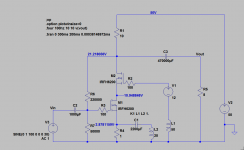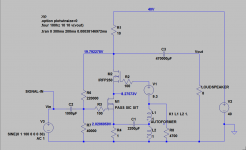I have been thinking about the ultra-linear cascode where you use two cascoded triodes and apply some feedback to the top triode gate. I have been wanting to "mosfetify" this circuit for some time as a way to modulate the transfercurves of mosfets.
There is a very interesting article over at TubeCad about Ultra-linear and ultra-linear cascode:
It's About Time & Ultra-Linear Line Stages
I can not explain the idea any better the he already has so I just copy his text into a quote here.
This circuit is quite worthless with a pentodish normal mosfet as the M1 bottom fet. It has to have a triode transfer-curve like a SIT, triode or an IRFP7430 for the feedback to have any real effect..
I don't know if this is worth exploiting, but I do have to test it.
This is the way I imagine a simple transformer cascode modulation.
Since I don't have any SiC SITs I will have to use my IRFP7430 as M1 in the circuit below.

I hope I can write more tomorrow after I test this circuit.
Cheers,
Johannes
There is a very interesting article over at TubeCad about Ultra-linear and ultra-linear cascode:
It's About Time & Ultra-Linear Line Stages
We know that if the screen in a pentode sees a steady fixed DC voltage, the pentode will function as a pentode, with high gain and poor PSRR; we also know that if the screen sees 100% of the plate’s output signal, the pentode will function like a triode, with lower gain, distortion, and improved PSRR; moreover, we know that we can feed the screen some ratio of plate signal in an ultra-linear fashion. So at one extreme, we have pure pentode; at other, pure triode; and in between, ultra-linear. Now, what would happen if we fed the screen more than 100% of the plate output signal, say 130%? In other words, what would happen if we amplified the plate output signal, preserving its phase, but increasing its amplitude; and then we fed this bigger signal to the pentode’s screen? Ultra-supra-mega-triode operation? A reasonable assumption would be that the gain, distortion, and output impedance would drop further.
I can not explain the idea any better the he already has so I just copy his text into a quote here.
This circuit is quite worthless with a pentodish normal mosfet as the M1 bottom fet. It has to have a triode transfer-curve like a SIT, triode or an IRFP7430 for the feedback to have any real effect..
I don't know if this is worth exploiting, but I do have to test it.
This is the way I imagine a simple transformer cascode modulation.
Since I don't have any SiC SITs I will have to use my IRFP7430 as M1 in the circuit below.

I hope I can write more tomorrow after I test this circuit.
Cheers,
Johannes
Attachments
Last edited:
Just try to avoid Ultra-supra-mega-diode operation
😀 LOL!
I will really try not to add the "super-mega-diode" to my Ultra-Triode experiments...
Since the diode rectifies AC, I guess any music would turn into an infinite exponentially increasing DC, and that can't be any good.
Cheers,
Johannes
- Status
- Not open for further replies.
